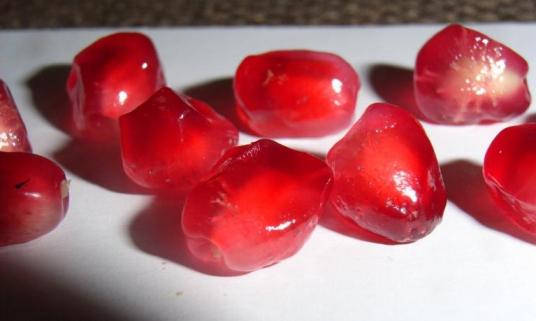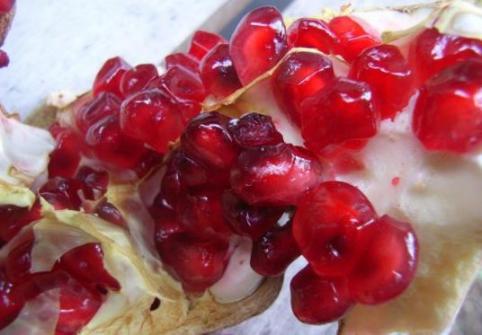
|
|
|
カテゴリ:花と緑と菌類と
 ガーネットのことを日本語では柘榴石と言いますが、柘榴の実の一粒一粒は、本当に宝石のようにきれいです。 In Japanese, garnet is called zakuro-ishi, meaning pomegranate stone. The arils are really beautiful like jewelry.  私は子どもの頃から半透明にキラキラした柘榴の実を眺めるのが大好きでした。ガーネットは私の誕生石でもあります。 I always liked its translucent ruby-like beauty ever since I was little. Garnet is also my birthstone.  熟し過ぎかなという状態になると、黒みを帯びた赤色になります。 When over-ripened, the red colour gets tinged with black. 安産や子育の神、鬼子母神の伝説があります。多くの子どもを持ち、慈しんでいた鬼子母神は、一方で人の子どもを取って喰っていました。あるとき釈迦がその過ちを正すため、鬼子母神の子どもを一人、隠してしまいます。気違いのように子どもをさがし、子どもを失う辛さを知った鬼子母神は心を入れ替え、その後は子どもを食べたくなったら、釈迦の教えのとおり、代わりにザクロを食べたそうな。 そのため、ザクロは人肉の味がすると言い伝える地方もあるようです。もともとはインドあたりから伝わってきた話のようですが、もしかすると、実の赤い色合いが血の色を思わせることも、言い伝えに関係があるのかもしれません。 ちなみにザクロには 「子宝」 「繁栄」 「生命の果実」 の意味があり、また 「知恵の木」 などとも言われるようです。花言葉を調べてみたら、「円熟した優美」 や 「男女の愛」 「互いに思う」 に加えて、 「愚かしさ」 というのも出てきましたヨ。「おバカなザクロ」・・なんちゃって、けっこう好きかも。味は甘酸っぱく、あくまでも果物です。(^0^)/ We have a legend in Japan about goddess Kishimojin (or Kariteimo), who is now believed to be protecting children, likely originated in India. It says that the goddess had many children herself and loved them much, but on the other hand, she had a habit of taking and eating children of others. Shaka (or Buddha), to cure her child-eating, hided one of her children. After desperately looking for her lost child without success, Kishimojin realized what a pain of loosing child she had been causing to the others. Shaka gave the child back to her and suggested her to eat some pomegranate fruits if she ever again felt like eating a child. This legend seems to have created a tradition in some areas that the fruit tastes like human flesh. I wonder if its dark red colour which can be compared with blood has contributed to the establishment of the tradition. As a matter of fact, a pomegranate fruit never tastes like meat, but does taste like a fruit. it tastes quite good actually; it is basically sweet and a little bit sour. (^0^)/ November 2009 / Nishinomiya, Hyogo お気に入りの記事を「いいね!」で応援しよう
[花と緑と菌類と] カテゴリの最新記事
|